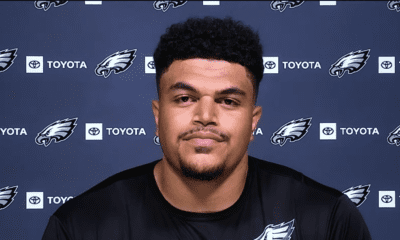Steelers News
What’s the Next Step for the Steelers Offense?

PITTSBURGH — The Pittsburgh Steelers have done a better job of moving the ball down the field since turning to Kenny Pickett as starting quarterback in the first quarter of their season.
That improvement in moving the ball has mostly been offset by a dramatic increase in the number of turnovers as the team transitioned to the rookie passer.
Against the New Orleans Saints on Sunday, Pickett showed dramatic improvement in that regard. Even though he was sacked six times, flushed from the pocket many more, and forced to run for a career high in yardage and throw the ball away repeatedly, Pickett did not throw an interception over the course of 60 minutes for the first time in his career.
That improvement probably won’t be as easy to maintain as it was against the suspect Saints, but it sure felt as if there was a demonstrable shift in Pickett’s care for the football that should be able to carry over as the Steelers continue the second half of their season.
But of course, even by moving the ball more efficiently than they had, and even though they didn’t turn the ball over (and got two interceptions and a fourth-down stop from their defense), the Steelers offense scored just 20 points in the win over New Orleans.
The median NFL scoring average right now is 22.2 points per game, so even a winning performance for the Pittsburgh offense checked in at below average.
So what does the Steelers offense need to do to score more points?
One of those ways is to be better in the red zone. The Steelers got two touchdowns from five trips to the red zone on Sunday. They are currently tied for 28th in red-zone touchdown percentage, and while most of their offensive numbers are toward the bottom of the league, that seems one that they’re keen on improving going forward.
That’s because they should be capable of better. One of the big positives of Pickett’s rookie season has been his accuracy. Entering Week 11, Pickett is tied for ninth in the NFL with a 66.7 completion percentage. He’s tied with Kyler Murray. He’s completed more of his passes than Tom Brady, Justin Herbert, Trevor Lawrence, Aaron Rodgers and Josh Allen. That’s a really strong performance for a rookie.
But it’s one that’s falling apart in the red zone. Inside opponents’ 20-yard lines, Pickett has completed just 40.9% of his passes, third-worst in the NFL ahead of only Derek Carr and Joe Flacco.
“We’re not where we need to be,” Pickett said Thursday.
So, what’s the problem?
In the red zone, defenses are no longer afraid of getting beaten deep, so they play tighter coverages and jump more underneath routes. Everything becomes slightly more difficult and all of the passes come with more actual and implied risk.
Tighter coverage means more chances that a ball can be tipped, and tipped balls can lead to interceptions. An interception in the red zone is at least a three-point swing in the opposing team’s favor, as an incomplete pass would at least lead to a field goal try.
So they’re tougher throws and they have higher stakes. It requires a great deal of confidence to be good in the red zone, both in the quarterback’s own abilities and confidence in his teammates to be exactly where he thinks they’ll be, when he expects them to be there, and that they’ll come down with the ball, even if they’re not all that open.
“So, it’s tighter windows, the timing, everything’s faster,” Pickett explained. “I’ve got to meet the guys at certain spots with the ball; they’ve got to get there on time. The game changes when you get down there. The calls change, the system really changes. There’re things that we definitely need to get better at. I think we’ve definitely had improvements, but we’re not where we need to be.”
Twice against the Saints, the Steelers got tight end Pat Freiermuth into a look that provided Pickett and opportunity to throw relatively low-risk passes to the side or corner of the end zone.
Neither was complete, though Freiermuth did draw a defensive pass interference penalty on the second one. Freiermuth said that even though they weren’t complete, he thinks Pickett having the confidence to throw those passes even with minimal separation between Freiermuth and the defender is a good sign for their future red-zone hopes.
“Nothing bad is going to happen out there,” Freiermuth said. “We’ll get a call or gonna catch the ball. Me and Kenny just need to go down there and execute more.”
The fine precision necessary to complete those red-zone throws has brought out something of an issue with Pickett’s progression. He entered the offseason as the third-string quarterback. He spent most of the summer throwing to guys that are currently at home on their couch.
“We didn’t get a lot of reps in camp because of the situation,” Freiermuth said. “We’re still working through that.”
Pickett has been taking time while the No. 1 offense is not on the practice field to work off to the side with Freiermuth, George Pickens and Diontae Johnson, in the hopes of replicating some of the additional reps they would have gotten if they had worked together all summer.
RELATED: Daily Links: Kenny Pickett Puts in Extra Work
“Not having the summer obviously hurts with timing and reps,” Pickett said. “So, being able to get free time when the defense is out there working off to the side on whatever extra routes we need, timing purposes, those guys are great. They give full effort, and I can get timing. It’s been going pretty well so far.”
Much like when the Steelers sat down during their bye week to work on the turnover problem, it seems that they’ve identified an issue that has been holding back their offense, and are taking steps to minimize it going forward.
Now we’ll see if they’re able to get improved results on the field in this area, as well.













